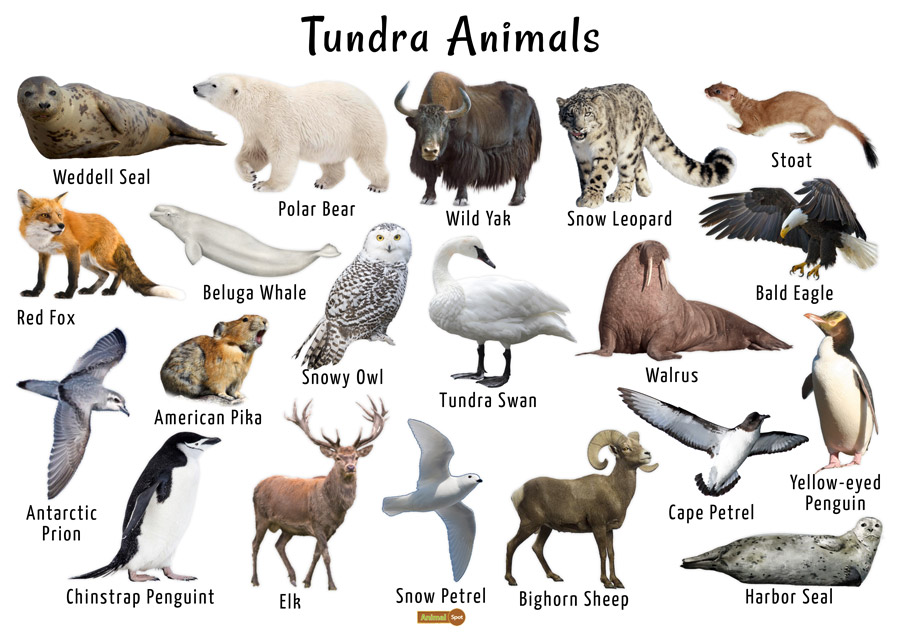Tundra Animals List, Facts, Adaptations, Pictures
Tundra includes some of the most inhospitable regions in the world, characterized by sub-zero temperatures and short growing seasons. The three geographically distinct regions are the Arctic tundra, alpine tundra, and the Antarctic tundra. Vegetation in these regions comprises of sedge, moss, lichen, dwarf shrub, and grass, while larger trees may also grow in a scattered fashion.

Tundra Biome Animals
Tundra Biome Animals
Animals living in these regions need special adaptations to deal with the extreme cold. Even with the hostile climatic conditions, there are hundreds of types of mammals, birds, and aquatic animals found here.
Adaptations: How do animals survive in the tundra biome
Surviving in the cold
- Animals living in the tundra regions have thick fur and extra layers of fat to keep them insulated.
- The bodies of most animals are large with short limbs and tails helping them to retain heat within their body as much as possible.
- Birds of the tundra usually have two layers of thick feathers to stay warm.
- Animals like bears, arctic squirrels, and marmots hibernate through the winter season.
- Smaller animals like lemmings and stoats dig holes, known as burrows and spend the cold season in there.
- Many animals, especially birds, migrate away from the Tundra during the winter season, and come back during the brief summers.
Locomoting on the snow
- Most ground-dwelling species have a characteristic fur lining on their feet to prevent them from getting too cold when walking long distances.
Camouflaging to the surroundings
- Many animals of this region are white in color so they can blend in with the white snow, and use it as an effective camouflage. This adaptation is useful for both predator and prey. Arctic foxes lose their white fur in the summer to maintain the masquerade through that season.
- Penguins have a unique coloration because of their regular forays in the water. For something that looks up towards the surface of the water, the penguin will blend in with the skies above, and for predatory birds looking into the water from above, it blends in with the black background of the sea floor.
Optimizing food resources
- The competition for food is naturally extremely high, especially during the winter months. So, many tundra animals have been seen to grow at a slower rate to optimize whatever little food they get during the summer.
Conservation status: Are there any endangered animals in the tundra
Because of the difficulty of access to humans, and the sheer inhospitable environment that it poses to humankind, most of the animals of the tundra ecosystem are relatively safe. Although the populations of some animals, like polar bears, Eskimo curlews, and the Arctic subspecies of the peregrine falcon, have been on a downward spiral for the past few decades because of the improvements in technology and man’s ability to finally catch up and deal with the harsh conditions of the tundra.
Did You Know?
- The word tundra comes from the Finnish term ‘tunturia’, which means ‘treeless plains.’
- The snow-covering of the ground is thick enough to actually provide ample insulation for burrowing animals.
- Even during the summer season, the temperatures do not exceed 10°C (50°F), and the daytime hours can last for up to 24 hours in the Polar Regions.
- The dominant animals in the tundra food chain, including the Arctic fox, polar bear, and Arctic wolf, obtain water from the body of their prey.
- One example of a symbiotic relationship in the tundra would be where a fox follows a caribou in search of food so the latter can dig holes in the ground to get lichens for itself, exposing some subnivean animals in the process that the fox can feed on.
- Polar bears rarely drink water; they chemically break down fat within their body to make water instead. The fat sources are replenished by feasting on the fatty parts of their prey, particularly the blubbers of seals. Most other parts of the seal’s body are left for scavengers.






